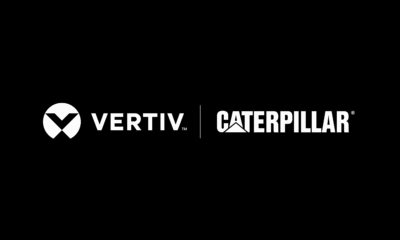Tech Features
ASUS Techsphere Forum: Empowering Business Leaders Through Next-Gen Hardware Innovation

The line on the opening slide— “Every company will be an AI company”—wasn’t tossed out as a provocation. At the ASUS Techsphere Forum 2025 in Dubai, it landed as an operating instruction. The message across keynotes, the Intel segment, and two candid panels was strikingly consistent: AI stops being theatre the moment you standardize three things—the workspace (where people actually work), the runtime (so models are portable), and the portfolio (so you manage dozens of use cases like a product backlog, not a parade of proofs-of-concept).

Subrato Basu, Managing Partner, Executive Board
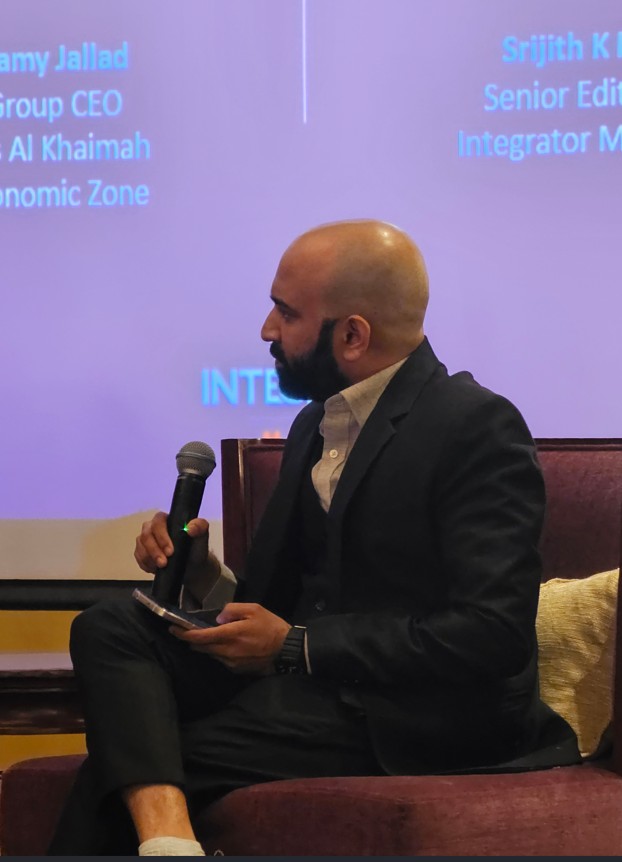
Srijith KN,
Senior Editor,
Integrator Media
A quick reality check on market size so we’re not drinking our own Kool-Aid: the global AI market in 2025 is roughly $300–$400B, depending on scope (software vs. software + services + hardware). Reasonable consensus ranges put 2030 at ~$0.8–$1.6T. In other words, still early—but already too big to treat as a side project.
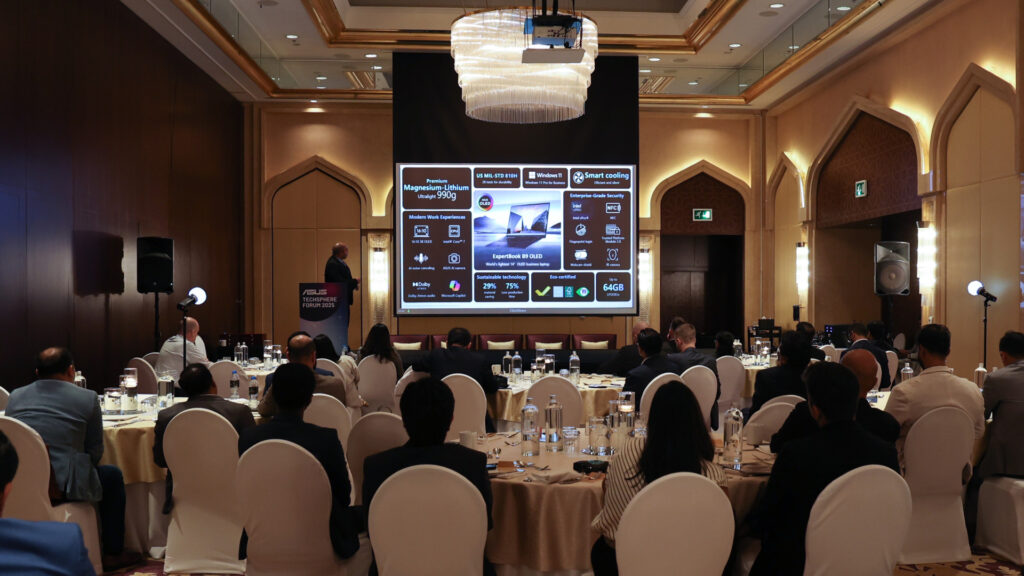
ASUS: PUT AI ON THE ENDPOINT—AND MAKE IT GOVERNABLE
ASUS’s enterprise stance is disarmingly practical. As Mohit Bector, Commercial Head (UAE & GCC) at ASUS Business, framed it, the fastest way to make AI useful is to put it where the work happens (the endpoint) and to make it governable. Concretely, that means:
- NPUs for on-device inference (privacy, latency, battery life).
- Manageability (fleet policy, remote control, security posture you can actually audit).
- Longevity (multi-year BIOS/driver support) so IT can set an AI-ready baseline and keep it stable.
ASUS thinks about the modern workplace as an Enter → Analyse → Decide loop, this is where the workday actually speeds up—quietly, relentlessly, at the endpoint:
- Enter: the device captures signals—voice, docs, screens, forms, sensors.
- Analyse: retrieval-augmented reasoning + analytics produce options, risks, and rationales.
- Decide: humans choose; agents act—raise tickets, update ERP/CRM—with audit trails.
It isn’t about one blockbuster use case. It’s about standardizing the canvas, so small wins compound every week.
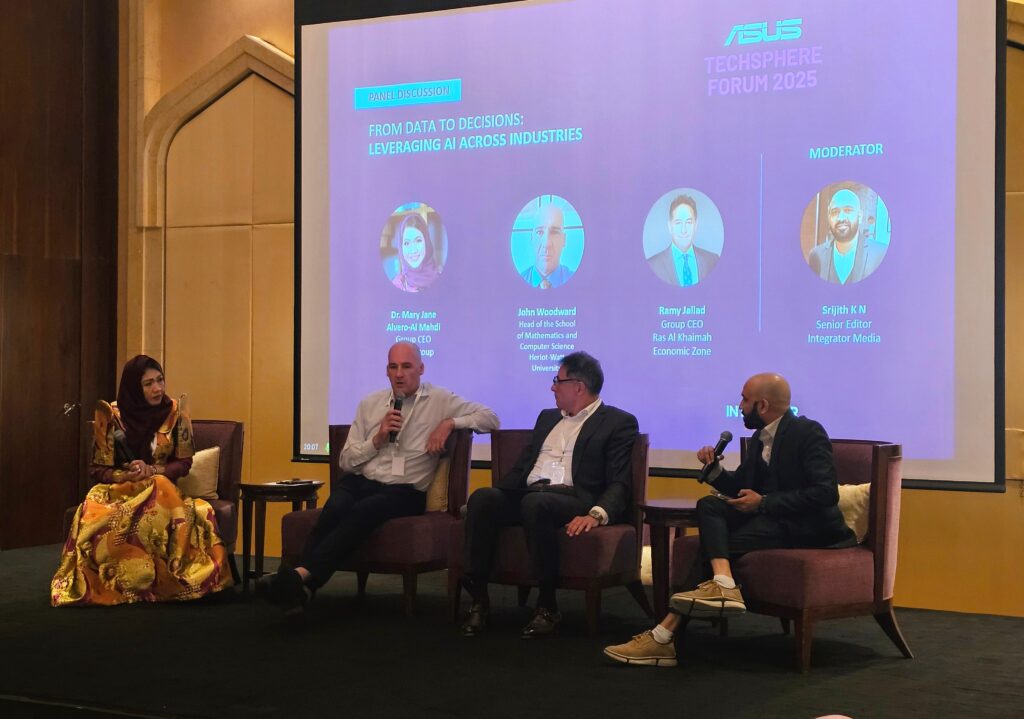
INTEL: FROM SLOGAN TO STACK (AND WHY THE AI PC MATTERS)
Intel’s deck made the “every company will be an AI company” claim implementable. Four slide-level words—Open, Innovative, Efficient, Secure—double as a buyer checklist:
- Open: less cost, no lock-in. The same models should move across CPU/GPU/NPU and PC → Edge → Datacentre/Cloud without rewrites.
- Innovation: treat AI PCs with NPUs, edge systems, and cloud clusters as one continuum.
- Efficient: lead on performance per dollar and per watt; energy and cost are first-class design goals.
- Secure: your data and your models are IP; run locally when you should, govern tightly when you don’t.
A “Power of Intel Inside” platform slide stitched this together:
- AI software & services: OpenVINO as the portability layer to convert/optimize/run models across heterogeneous silicon.
- AI PC: always-on, private inference for day-to-day assistants.
- Edge AI: near-machine intelligence for vision and time-series use cases.
- Datacentre & cloud AI: scale-out training/heavy inference (fraud graphs, multimodal analytics, enterprise RAG).
- AI networking: the fabric that keeps it all moving—securely.
Why the fuss about the AI PC? Because it’s the next enterprise inflection after Windows and Wi-Fi. Slides mapped tangible outcomes:
- Productivity: faster info-find, auto-drafts, note-taking.
- Communication: translation, live captioning, dictation, transcription.
- Collaboration: smart framing, background removal, eye tracking, noise suppression—without pegging the CPU.
- IT operations: endpoint anomaly detection, VDI super-resolution, remote screen/data removal.
- Security: client-side deepfake detection, anti-phishing, ransomware flags.
Under the hood, Intel’s definition is a division of labour: CPU for responsiveness and orchestration, GPU for high-throughput math/creation, NPU for low-power sustained inference—the always-on stuff that makes assistants truly useful. Add vPro + Core Ultra and you get the fleet controls and long-term stability IT actually needs.
One more practical bit I liked: Intel AI Assistant Builder—a portal to stand up local assistants/agents (with RAG) that can run on the PC fleet first, shrinking time-to-value from months to days/weeks and letting you prove the full E-A-D loop before you scale heavier jobs to edge/cloud.
When the “100M AI PCs by 2026” slide hit the screen, heads tilted from curiosity to calculation. The figures—bullish vendor projections (~100M by 2026; ~80% AI-capable by 2028)—invite a haircut, but the signal is unmistakable: endpoint AI is becoming the default.
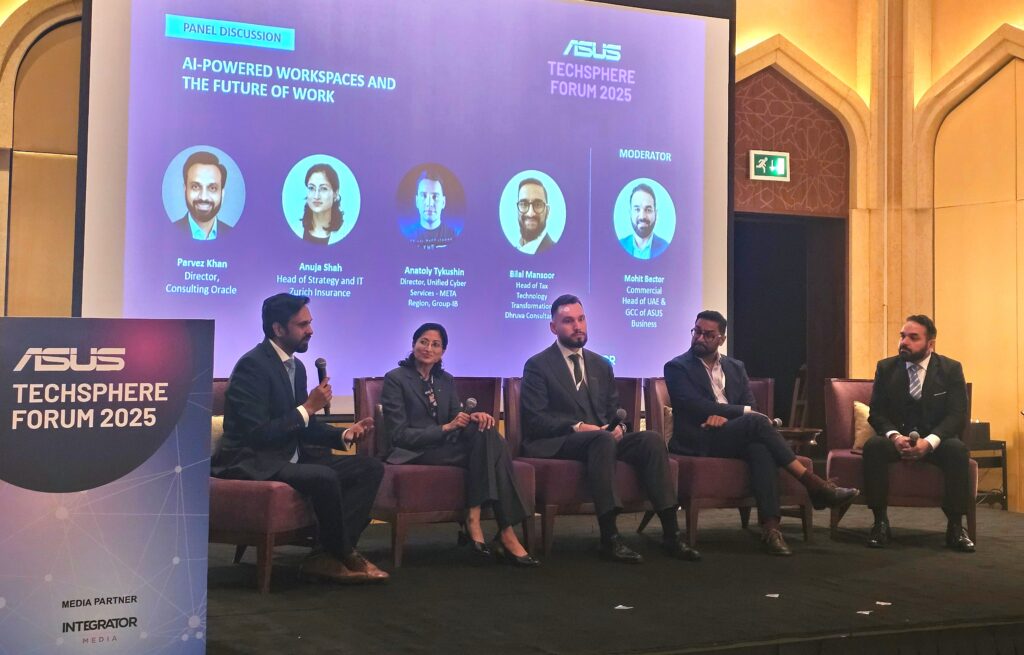
WHAT THE PANELLISTS REALLY TAUGHT US
RAKEZ (Free Trade Zone)
Posture: Execution-first. Make AI practical on the shop floor and trustworthy in the back office—governed from day one.
What they drive:
- Diagnostics (OEE baselines, defect maps) + data-readiness scans (MES/ERP) so pilots don’t stall.
- Reference lines/sandboxes where vendors prove accuracy, safety, throughput before purchase.
- Template playbooks: CV-QC, predictive maintenance, warehouse vision, invoice extraction/3-way match—each with SOPs, KPIs, integration steps.
- Curated vendors + shared services (labelling, model hosting/monitoring, SOC for AI) to reduce MSME cost/complexity.
MSMEs: “Bookkeeping-in-a-box” to clean ledgers and free cash; pre-negotiated PoC packs (fixed price/timeline, acceptance metrics); compliance starter kit (consent, retention, safety, escalation).
Enterprises: Multi-site rollout playbooks, edge + cloud reference architectures (identity-aware RAG, policy-constrained agents), and assurance artifacts (model cards, change control, audit trails).
Outcome lens: OEE ↑, FPY ↑/DPMO ↓, MTBF ↑/MTTR ↓, faster close cycles, fewer incidents—AI that moves the P&L and passes audit.
Note – FPY — First Pass Yield; OEE — Overall Equipment Effectiveness; DPMO — Defects Per Million Opportunities; MTBF — Mean Time Between Failures (repairable systems); MTTR — Mean Time To Repair
Oracle (Consulting / Applications cloud)
Posture: AI belongs inside the workflows where finance, HR, supply chain, and service teams live. Expect talk tracks like: ground answers in your own records (RAG with policy), instrument before/after outcomes, and treat AI features as part of ERP/HCM/CX—not a sidecar chatbot. The ask from buyers: prove the Enter → Analyse → Decide gains in real workflows (FP&A forecasting lift, supplier risk scoring, HR talent match quality).
Zurich Insurance (BFSI)
Posture: AI as a force for good, scaled with governance. Think hundreds of use cases: claims triage, fraud/anomaly detection, internal knowledge bots—human-in-the-loop where stakes are high, and IoT-style prevention to reward good behaviour. The key is measurement: fewer false positives, shorter cycle times, clearer audit trails—and elevated roles, not replaced ones.
Group-IB (Cyber / Threat Intel)
Posture: AI to defend—and defend against AI. SOC copilots that summarize and enrich alerts, deepfake/phishing detection, behaviour analytics across identities and endpoints, and the emerging discipline of security of AI (prompt-injection defences, LLM gatewaying, data loss controls for AI apps). If you’re rolling out agents, involve your security team early.
Dhruva Consultants (Tax Tech Transformation)
Posture: RegTech + AI to reduce compliance cost and risk. Document AI to normalize invoices/contracts, anomaly detection for mismatches and fraud flags, and a pragmatic “bookkeeping-in-a-box” on-ramp for MSMEs. Non-negotiables: auditability, versioning, segregation of duties for anything that touches filings.
Prime Group (Labs/Certification)
Posture: Risk-scored processes—every lab step tagged with expected outputs, data access, and fallbacks. Near-term wins: smarter scheduling and test selection; long-term horizon: a Mars-ready lab by 2050 aligned with the UAE’s space ambitions. It’s operational excellence today, exploration mindset tomorrow.
Education (Heriot-Watt University, Dubai)
Posture: candid and useful: human-led pedagogy; AI-assisted admin and decision support. HWU brings talent pipelines (AI/Data Science programs), translational research, and applied robotics capacity (think Robotarium-style ecosystems). This is the repeatable talent + research engine enterprises can plug into—capstones, CPD, joint R&D—that shortens the path from idea to pilot.
WHY UAE HAS A STRUCTURAL ADVANTAGE: RAKEZ × HWU
Local context matters. RAKEZ (Ras Al Khaimah Economic Zone) is more than a location; it’s an adoption on-ramp aligned with MoIAT’s Industry 4.0 programs (ITTI/Transform 4.0). Translation: factories—especially MSMEs—get real help to deploy vision-led quality, OEE analytics, and worker-safety use cases, with policy scaffolding and incentives attached.
Pair that with Heriot-Watt University as a talent/research flywheel and you have a short, well-lit path from concept to production: execution zone + skills engine. That’s a genuine regional edge.
SUMMARY
Techsphere’s most important contribution wasn’t a prediction; it was a design pattern. ASUS gives you the enterprise substrate (AI-ready endpoints you can actually govern). Intel gives you the principles and plumbing (OpenVINO portability; CPU/GPU/NPU continuum; PC → Edge → Cloud). The panellists supplied proof patterns across industries. And the UAE context—RAKEZ for execution, HWU for talent/research—shortens the distance from idea to impact.
If “every company will be an AI company,” the winners won’t be the first to demo—they’ll be the first to standardize. Start at the endpoint, insist on portability, manage a portfolio, and make the Enter → Analyse → Decide loop measurable. That’s how the slide turns into the balance sheet.
_________________________________________________________
- Glossary of Technical Acronyms
- OEE — Overall Equipment Effectiveness (measures manufacturing productivity: availability × performance × quality).
- FPY — First Pass Yield (percentage of units passing production without rework).
- DPMO — Defects Per Million Opportunities (defect rate in Six Sigma terms).
- MTBF — Mean Time Between Failures (average time between breakdowns of a repairable system).
- MTTR — Mean Time To Repair (average time to repair a failed component/system).
- AI / IT Terms
- NPU — Neural Processing Unit (specialized chip for AI inference, optimized for low-power sustained workloads).
- CPU — Central Processing Unit (general-purpose processor for orchestration, responsiveness).
- GPU — Graphics Processing Unit (parallel processor for high-throughput math and AI training/inference).
- RAG — Retrieval-Augmented Generation (technique where AI models query external knowledge bases before generating answers).
- ERP — Enterprise Resource Planning (integrated system for core business processes like finance, supply chain, manufacturing).
- MES — Manufacturing Execution System (software for monitoring and controlling production).
- VDI — Virtual Desktop Infrastructure (running desktop environments on centralized servers).
- SOC — Security Operations Center (hub for cybersecurity monitoring and response).
- IP — Intellectual Property (protected data, models, or designs).
- Industry & Enterprise Acronyms
- BFSI — Banking, Financial Services, and Insurance (industry vertical).
- FP&A — Financial Planning & Analysis (finance function for budgeting, forecasting, performance analysis).
- HCM — Human Capital Management (HR technology and processes).
- CX — Customer Experience (customer-facing processes and software).
- ITTI — Industrial Technology Transformation Index (UAE Ministry of Industry and Advanced Technology initiative under Industry 4.0).
The ASUS Techsphere Forum, organized by Integrator Media, brought together C-suite leaders from diverse industry verticals to explore how evolving hardware standards are shaping the future of work. The event highlighted the growing role of AI-enabled PCs, showing how advancements in endpoint hardware can directly support business needs. By balancing industry-specific requirements with insights on hardware innovation, the forum offered executives a clear view of how these technologies can enhance productivity and deliver measurable value across the wider business community.
Tech Features
HR-led Initiatives to nurture women-led TECH startups

Professor Fiona Robson,
Head of the School of Social Sciences & Edinburgh Business School
HR is no longer just about recruitment and retention – there is a growing trend towards taking a more creative and innovative approach. This can involve looking at talent through different lenses rather than seeing it as a hierarchical talent management process focusing on vertical promotions within the organization.
In an age where HR rightly have a seat at the strategic table for decision making, they have the opportunity to ensure that appropriate levels of funding and expertise are used to develop a forward-looking talent strategy that goes beyond the norm. Artificial intelligence (AI) brings a plethora of opportunities for organisations to be braver in how they identify potential talent. Using AI to identify talent can be a useful starting point but when it comes to areas such as innovation and identifying an entrepreneurial mindset, it may be more difficult to pinpoint the traits which could indicate potential to innovate.
Where HR teams start to consider and plot non-traditional pathways they may be able to recruit and retain employees with diverse skillsets. Taking an entrepreneurial path opens up the talent pool as it isn’t as focused on people looking at the next hierarchical step up within the organisation. This is important as there are usually resource constraints about how many vacancies are available to fill at the highest pay grades in the organisation. These new pathways should provide opportunities for women to shine in different types of projects and recognise the strategic importance of creative thinking and innovation.
Providing testing opportunities
Depending on the level of finance available there are some additional resources that could be provided. Innovation sprints or challenges can be a great way to test out ideas and receive feedback from different groups of stakeholders. They may facilitate prototyping and identify issues that were not previously considered. Internal technology venture labs can also provide a safe environment to test out ideas and proof of concept. Collaborating with Universities who are experienced in running labs and sprints can be very beneficial, they may also have access to funding to support the development of new products and services. However, in order to be truly successful, they need to ensure that there is a sustainable follow up process before the momentum deflates.
Inclusive Procurement and Equitable IP Policies
Organisations can seek to lead the way and exhibit good practice by reviewing their procurement policies where practicable to ensure that they are inclusive. Examples may include having provision for flexible payment terms which would make it easier for those at the beginning of their entrepreneurship journey. Access to specialist support which could help women to set up their businesses in a more timely way could also break down some of the perceived barriers. Often the processes around procurement can be rather cumbersome so the provision of training which shows exactly how to navigate it could be helpful. Forward looking organisations might seek to approve a process whereby women entrepreneurs are given priority with their applications.
For many women, even thinking about intellectual property (IP) and patents can seem overwhelming if they have never had exposure to this world before. The introduction of simplified processes could act as a springboard to attract more women, particularly if the timeline can be expedited so that there is a shorter gap between the initial idea and when it is approved. Having access to real case studies showing how this happens would also be reassuring. In large organisations, the HR team may be able to encourage the legal team to provide some initial advice so that prospective entrepreneurs get a realistic insight into whether their proposal has merit or not.
Commercial Advantage Through Policy
HR can make a name for itself by encouraging innovation through widening participation and breaking down barriers to encourage, support and recognise innovation. For some HR professionals this may be quite a shift for them so they may also require some reskilling and retraining.
It would be good practice for organisations to regularly review their HR policies to ensure that they reflect the changing eco-system and that there are appropriate diversity clauses within the library of policies, procedures and practices. As part of this, ensuring that there is awareness of bias and how this can sneak into processes unconsciously and inadvertently disadvantage women. The establishment of women’s networks would be a proactive approach and could help them at all of the different stages of developing and executing their entrepreneurial ideas.
Providing funding opportunities may be one of the most impactful decisions that an organisation can make. Obviously this would need to have transparent parameters around it but it could be the difference between an idea being turned into practice or not. If the funding allocation is governed by stakeholders with appropriate expertise in different areas i.e. finance, law, governance and people, this would reduce the organisational risk of investing in small new businesses. Where there isn’t a potential conflict of interest, organisations could also make a significant impact by facilitating market entry and opening doors within networks and supply chains.
Tech Features
The Future of Work-Integrated Learning: Embedding HR Tech Practices in Higher Education

Professor Fiona Robson, Head of the School of Social Sciences and Edinburgh Business School, Heriot-Watt University Dubai

Universities have a responsibility to prepare students for their future career in terms of both skills and knowledge. In an increasingly technological world, managers of the future need to understand the capabilities of HR tech as well as being able to use it.
Exposing students to HR tech platforms can help to prepare them for their future career in HR in terms of skills but also understanding what is going on in the HR space – understanding the priorities and why use of technology is growing. Being familiar and comfortable with HR tech might help them to stand out in the graduate marketplace and from an employer’s perspective could help them hit the ground running. Being able to analyse data to inform organisational decisions is critical and HR tech gives them the ability to get good data and then learn how to use it to make appropriate data-driven decisions.
Real play rather than role play is particularly helpful for students as the learning is more meaningful, and they can visualise what would happen in the workplace. Therefore, using software which is being used in real organisations will add great value to their learning experience and what their future role might involve. Where University academics have strong relationships with industry, they may be able to use real data so that the students get a realistic experience and understand the complexity of what organisations have to contend with.
Where the HR tech has the capability to provide commentary based on the student performance in using it, this is a further source of information of formative feedback which helps students with their academic and personal development. Developing students’ confidence in using tech should not be underestimated as if they have the knowledge but are afraid to use it, their impact will be limited. Ideally, organisations are looking for graduates who are comfortable in learning to use new programmes and understand some of the teething troubles that can emerge when introducing new tech.
Involving HR professionals within the classroom adds significant value to students and helps them to understand the diverse nature of working in an HR team. Therefore where learning to use the HR tech platform can be married with having an HR professional to talk them through how it can be used and the impact of using it, this would further strengthen their learning and experience. There can also be benefits for HR professionals, as they can gain perspectives from students that may differ from those they encounter in the workplace—particularly if they are interested in potential generational differences. Sharing their own knowledge and skills and presenting to University students can also be very beneficial to the personal and professional development of the HR professional.
Organisations are ideally looking for graduates who are confident in using technology and open to trying new systems and ideas, and therefore, if they have been exposed to different types of tech, this could give them an advantage. They can also learn about some of the wider things about technology implementation – for example, issues around ethics as well as the data protection and legal implications of having access to sensitive and confidential information.
Opening Doors with Internships
Internship programmes provide great insights into the industry and allow students to see the links between theory and practice. It also enables them to see all of the different internal and external factors which can have an impact on organisations, and this can be very eye-opening for them. Understanding the roles of different stakeholders is usually one of the key learning points from internships.
In the classroom, we can teach students the theory about organisational culture and individual and team dynamics; however, an internship is where they can see what this actually looks like. Being able to observe how different departments collaborate may help them to make sense of some of the topics they have studied as part of their degree programme.
We shouldn’t underestimate the importance of learning to build relationships in the workplace and to recognise and respond to issues like organisational politics. For some students, exposure to an internship can help cement their career aspirations in identifying which areas of business they find most interesting, and for some students they will be attracted to roles that they may previously not have been aware of.
As most businesses now have an international aspect, it is also valuable for interns to learn about the different angles of internationalisation and what this means for people in their day-to-day activities. Typically they may recognise it is common for organisations to have international customers but may not have considered international supply chains and the complexities of having employees in different countries which operate under different jurisdictions. It may also reiterate the importance of developing the cross cultural skills that they are taught by their lecturers.
If students’ internships are successful and they are identified as being potential talent of the future, the organisation may begin a longer-term relationship with them. For example, they may allow them to focus their dissertation within the organisation or offering them a job once they graduate.
Tech Features
How are leaders in the Middle East using AI to solve for supply chain issues

Attributed by Harsh Kumar, Chief Strategy Officer, Shipsy
The Middle East’s logistics sector is undergoing a fundamental change as industry leaders embrace AI to tackle region-specific challenges and build the foundation for autonomous supply chain operations. “In the wake of the fourth industrial revolution, governments and businesses across the Middle East are beginning to realise the shift globally towards AI and advanced technologies. We estimate that the Middle East is expected to accrue 2% of the total global benefits of AI in 2030. This is equivalent to US$320 billion,” highlights a PwC Middle East report.
When it comes to making supply chains autonomous, logistics leaders in the Middle East agree that there are some inherent challenges in the region that hinder growth and that they are working towards addressing the same.
Addressing the Middle East’s Obstacles to Autonomous Supply Chains
Inaccurate addresses remain one of the most critical pain points for Middle Eastern logistics operations, directly impacting productivity, costs, and customer experience. The region’s diverse linguistic landscape and inconsistent address systems have made last-mile delivery particularly challenging.
In the Middle East, inefficient address structure often results in packages and letters being addressed only with a recipient’s name, city, and country, lacking a specific delivery address. Courier services are typically provided with just a name and mobile number, requiring them to investigate and determine the intended delivery location. According to a report by Logistics Middle East, incorrect addresses can potentially impact more than $7.42 billion in eCommerce revenue in the Middle East.
“AI’s success and differentiation from any other technology before it, will depend on its ability to solve region-specific challenges. Unlike banking and financial services sectors, logistics and supply chain operations often deal with fragmented processes and disconnected systems. AI is uniquely positioned to bridge these gaps by harmonizing data, streamlining workflows and enhancing efficiency across the entire value chain all of which have a direct impact on operational productivity.” said Iyad Kamal, ex COO of Aramex.
Incorrect addresses also create another challenge of driver productivity and retention. With retail customer expectations rising and delivery times shortening, logistics providers will need to focus on making it easier for drivers to complete their work, get the right information at the right time to ensure they deliver a better customer experience.
The challenge compounds due to a flawed hypothesis in route optimization which does not take into consideration real-world variables when allocating deliveries creating delays and impacting driver productivity. Another critical problem that needs to be addressed is financial settlements. Validating data for settlements remains a heavily manual and time-intensive process. It will not be incorrect to say that only about 10% of invoices are accurately validated, as the human effort required is significant. This results in a higher risk of inaccuracies in settlement. AI agents can help here by analyzing delivery proofs against trip data and automatically calculate delay fees using GPS timestamps and contractual rates.
How leaders are moving from Guesswork to Data-Driven Precision
Resource allocation has traditionally relied on intuition, resulting in suboptimal vehicle utilization and excessive mileage. Digital Twin technology is changing this paradigm by enabling logistics providers to run scenario analyses and predict the impact of different allocation strategies before implementation.
Real-time incident management has also evolved beyond manual dashboard monitoring. Autonomous monitoring agents now continuously check operations against KPIs, detecting anomalies like delays or harsh braking incidents. When issues arise, these agents assess impact, proactively communicate updated ETAs to customers, and suggest rescheduling options, thereby drastically reducing resolution times.
Aujan Coca-Cola Beverages Company is leveraging Agentic Incident Management, AI-powered dynamic route optimisation and load balancing and Agentic Control Tower to enhance customer experience by ensuring ETA adherence and real-time visibility.
Fair compensation and equitable workload distribution emerged as critical for combating driver attrition, with leaders emphasizing that rewards must be immediate rather than deferred to maintain motivation. Customer-centric execution requires moving beyond basic data matching. AI-enabled semantic matching creates comprehensive customer profiles that preserve delivery preferences across different drivers and addresses, ensuring consistent service quality.
“Verifying every transaction and validating every invoice, continue to be a massive overhead for supply chain leaders even in 2025. Companies that can leverage AI to automate highly human-intensive processes will unlock velocity as an advantage, making it harder for their competition to catch up.” said Soham Chokshi, Co-Founder and CEO of Shipsy, while emphasizing AI’s role in logistics.
The Road Ahead
Logistics leaders in the Middle East envision autonomous, intelligent, and customer-centric supply chains powered by agentic AI that independently solves complex problems. However, the success of these systems hinges on a human-in-the-loop approach. Balancing algorithmic optimization with human expertise, such as local knowledge and driver preferences, is essential to address the region’s unique challenges, like inefficient address systems. By integrating continuous monitoring and predictive intervention, AI can shift operations from reactive to proactive, but human oversight ensures adaptability and accuracy. This synergy between AI capabilities and human insight drives resilient, efficient, and customer-focused logistics networks.
As the region’s logistics sector continues its digital transformation, these AI-driven foundations are positioning Middle Eastern supply chains at the forefront of global innovation in autonomous operations.
-

 Tech News1 year ago
Tech News1 year agoDenodo Bolsters Executive Team by Hiring Christophe Culine as its Chief Revenue Officer
-

 VAR7 months ago
VAR7 months agoMicrosoft Launches New Surface Copilot+ PCs for Business
-

 Tech Interviews2 years ago
Tech Interviews2 years agoNavigating the Cybersecurity Landscape in Hybrid Work Environments
-

 Tech News4 months ago
Tech News4 months agoNothing Launches flagship Nothing Phone (3) and Headphone (1) in theme with the Iconic Museum of the Future in Dubai
-

 Tech News2 years ago
Tech News2 years agoBrighton College Abu Dhabi and Brighton College Al Ain Donate 954 IT Devices in Support of ‘Donate Your Own Device’ Campaign
-

 Editorial12 months ago
Editorial12 months agoCelebrating UAE National Day: A Legacy of Leadership and Technological Innovation
-

 VAR1 year ago
VAR1 year agoSamsung Galaxy Z Fold6 vs Google Pixel 9 Pro Fold: Clash Of The Folding Phenoms
-

 Cover Story9 months ago
Cover Story9 months agoUnifonic Leading the Future of AI-Driven Customer Engagement








